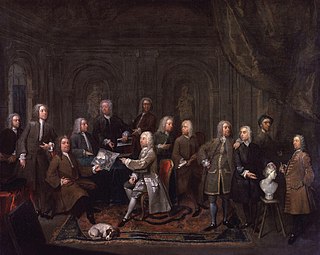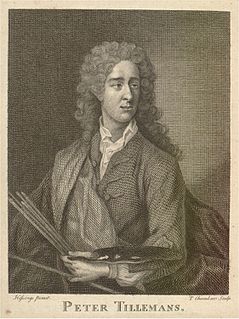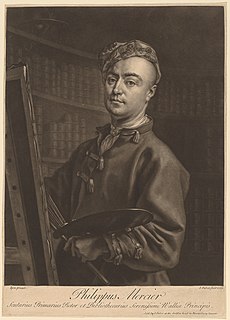
The Rose and Crown Club was a club for artists, collectors and connoisseurs of art in early 18th-century London, England.

The Rose and Crown Club was a club for artists, collectors and connoisseurs of art in early 18th-century London, England.
The Rose and Crown Club "for Eminent Artificers of this Nation" [1] [2] was formed by 1704, when the engraver George Vertue was admitted; [3] while it lasted, the club was among the more important of clubs for artists and connoisseurs. [4] According to John Smibert's biographer Richard Saunders, the club was initially "a bawdy assembly of younger artists and cognoscenti, which met weekly" [5] : 869 and apparently held its meetings at the Rose and Crown public house. [6] in addition to Vertue, members included Bernard Lens III, [7] Christian Friedrich Zincke, William Hogarth, Peter Tillemans, [8] Marcellus Laroon the Younger and Michael Dahl.
The members of the club were known as the 'Rosacoronians'. An unfinished Hogarthian conversation piece [9] painting in the Ashmolean Museum attributed to the Scottish painter Gawen Hamilton (another member), An Assembly of Virtuosi, shows a group of fifteen men, including eight who are identified in an etching of the painting by R. Cooper, published by W. B. Tiffin (1829), [10] and it has been suggested that this is a group portrait of the Rosacoronians. The group includes Hamilton himself, Michael Dahl, John Vanderbank, the architect William Kent, and John Michael Rysbrack the sculptor. [11] Vertue listed the painter and engraver Gerhard Bockman as a member in 1724. [12]
The club was well connected with the older-established Virtuosi of St Luke (c. 1689–1743), with which it is sometimes confused, although it was less prestigious. [2]
The Rose and Crown Club remained in existence until 1745 and held its last meeting at the Half-Moon Tavern. [13] Bignamini notes that
The meetings and annual feasts of the Virtuosi of St Luke and of the Rose and Crown Club had come to a definitive end in 1745. [14] [15]

George Vertue was an English engraver and antiquary, whose notebooks on British art of the first half of the 18th century are a valuable source for the period.

Louis-François Roubiliac was a French sculptor who worked in England, one of the four most prominent sculptors in London working in the rococo style, He was described by Margaret Whinney as "probably the most accomplished sculptor ever to work in England".

John Smibert was a Scottish-born painter, regarded as the first academically trained artist to live and work regularly in British America.

John Vanderbank was a leading English portrait painter who enjoyed a high reputation during the last decade of King George I's reign and remained in high fashion in the first decade of King George II's reign. George Vertue's opinion was that only intemperance and extravagance prevented Vanderbank from being the greatest portraitist of his generation, his lifestyle bringing him into repeated financial difficulties and leading to an early death at the age of only 45.

Peter Pelham, an American portrait painter and engraver, born in England, a son of a man named "gentleman" in his will. His father, who died in Chichester, Sussex, in 1756, is revealed in letters to his son in America as a man of some property.

Joseph Goupy (c.1689–1769) was an English engraver, painter, set designer and watercolourist. He was of French descent living and working in London from at least 1711.

Gawen Hamilton, easily confused with the later, more prominent artist Gavin Hamilton, was a Scottish painter working in London, a member of the Rose and Crown Club. He was one of the first wave of British born painters of 'conversation pieces' along with contemporaries such as William Hogarth and Charles Philips. These are works that depict groups of friends, families and acquaintances often engaging in a variety of genteel activities such as playing cards or taking tea. Some of Hamilton's pieces depict gatherings of artists and craftsmen such as the Rose and Crown Club itself.

Peter Tillemans was a Flemish painter, best known for his works on sporting and topographical subjects. Alongside John Wootton and James Seymour, he was one of the founders of the English school of sporting painting.

Philippe Mercier was an artist of French Huguenot descent from the German realm of Brandenburg-Prussia, usually defined to French school. Active in England for most of his working life, Mercier is considered one of the first practitioners of the Rococo style, and is credited with influencing a new generation of 18th-century English artists.
Johan Faber, anglicized as John Faber, commonly referred to as John Faber the Elder, was a Dutch miniaturist and portrait engraver active in London, where he set up a shop for producing and marketing his own work. His son John Faber Jr. was also active in this field.

Louis Chéron was a French painter, illustrator and art tutor.

Bernard Lens III was an English artist known primarily for his portrait miniatures. Lens was the miniature painter at the courts of kings George I and George II, instructor in miniature painting to prince William and princesses Mary and Louise and consultant in fine arts to upper-class families.
Bernard Baron was a French engraver and etcher who spent much of his life in England.
Gerhard Bockman (1686–1773) was a Dutch portrait painter and mezzotint engraver.
Claude Du Bosc was a French engraver, publisher, and printseller who spent much of his career in London. Associated with French contemporaries such as the painter Antoine Watteau and the draftsman Hubert-François Gravelot, Du Bosc belonged to the first wave of skilled engravers to arrive in London during the early 18th century, playing a major part in improving the standard of English printmaking of that era.

John Smith was an English mezzotint engraver and print seller. Closely associated with the portrait painter Godfrey Kneller, Smith was one of leading exponents of the mezzotint medium during the late 17th and early 18th centuries, and was regarded among first English-born artists to receive international recognition, along the younger painter William Hogarth.

Thomas Gibson was an English portrait painter and copyist, notable as master of George Vertue.
Jean Simon, anglicized as John Simon was an English mezzotint engraver and print publisher of French Huguenot birth, particularly known for his portraits. Notably associated with the German-born portrait painter Godfrey Kneller, Simon had an active career that spanned at least three and a half decades, and was regarded as one of the mezzotint medium's most prolific masters of his generation, along with the older contemporaneous engraver John Smith.

Marcellus Laroon the Younger was an English painter and draughtsman of French origin. He specialized in social genre scenes, and he frequented the world of actors and painters around Covent Garden in London that he painted. George Vertue, a contemporary who knew him well, said he painted for pleasure rather than profit.

Edward Cooper was an English print seller, regarded as the most distinguished print publisher of his generation and a leading figure in the art world.
{{cite encyclopedia}}: External link in |postscript={{cite encyclopedia}}: External link in |postscript={{cite encyclopedia}}: External link in |postscript=